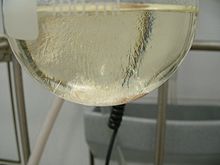Recrystallization

In chemistry , recrystallization is a cleaning process in order to convert raw products and preparations into purer end products by dissolving them and then recrystallizing them . It is based on the fact that the solubility of most substances is better in warm solvents than in cold ones. If a hot, saturated solution cools down, the solubility will eventually be exceeded and the substance will crystallize out again.
In mineralogy, recrystallization is understood to be the change in a crystal structure due to changes in external factors such as pressure and temperature conditions. The crystalline solid or the mineral changes its modification .
Chemical process

1. funnel
2. reflux condenser
3. 2-neck round bottom flask
4. Thermometer
In chemistry , recrystallization is understood to be a material separation process that is used as a cleaning process. A hot, saturated solution of a contaminated substance is produced, if necessary filtered while hot in order to remove insoluble contaminants, and the substance is made to crystallize again by cooling the solution . The desired substance is usually obtained in a purer form.
Colored impurities or cloudiness can often be removed by adding an adsorbent ( charcoal , bone charcoal , activated charcoal , active aluminum oxide , diatomite , filter flake mass, etc.). It is filtered from the hot saturated solution of the substance to be cleaned. Care must be taken to ensure that the solution does not cool down too much, otherwise the substance to be cleaned can crystallize out. For this reason, such filtration is usually carried out with heatable filters. The filtrate is then cooled and the substance crystallized.
The raw product is dissolved with a suitable solvent or solvent mixture.
The purification is based on the following effects:
- Solubilities: Impurities that are much more difficult to dissolve in the selected solvent can be filtered off from the hot, saturated solution; those that are more soluble preferably remain in the solution.
- Crystallization: If the desired substance is already present in a large excess in relation to the impurities, the statistical probability that molecules of the same shape will assemble in the crystal is greater than the incorporation of molecules with different shapes. These are only built into the edge area of the crystals at the end of the crystallization, where they can be removed by careful washing.
In contrast to this, a chemical separation process can also be carried out in which the substance (example: benzoic acid ) reacts with a substance to form a water-soluble substance (example: with sodium hydroxide solution to form sodium benzoate , acid-base reaction ), from which, by filtration, insoluble impurities are removed are separated and by adding a precipitant to the filtrate (example: a strong acid) then again (purified) benzoic acid is precipitated or just crystallized out. This method is called reprecipitation.
Recrystallization, reprecipitation and remelting
Related processes are reprecipitation ( reprecipitation , precipitation of unwanted components by other solvents) and remelting of a substance. Falling over is an ambiguous term. On the one hand, a chemical reaction can take place ( precipitation reaction ), but you can also reduce the solubility of the substance or an impurity to such an extent that it precipitates by adding a 'bad' solvent to a solution of the substance in a 'good' solvent. No solvent is used in remelting, but temperatures close to the melting point are used .
See also
- Recrystallization , a process used in metallurgy.
literature
- Heinz GO Becker, Werner Berger, Günter Domschke: Organikum . Wiley-VCH, ISBN 3527311483
- M. Büchli, P. Wörfel, M. Bitzer, U. Claus, H. Felber, M. Hübel, B. Vollenweider: Laborpraxis . Birkhäuser Verlag, ISBN 3764353066
- Hünig, Siegfried: Working methods in organic chemistry . Lehmanns Media, ISBN 3865411487 ( online version )
Web links
Individual evidence
- ^ Walter Wittenberger: Chemische Laboratoriumstechnik , Springer-Verlag, Vienna, New York, 7th edition, 1973, pp. 214-217, ISBN 3-211-81116-8 .
- ^ Walter Wittenberger: Chemische Laboratoriumstechnik , Springer-Verlag, Vienna, New York, 7th edition, 1973, p. 215, ISBN 3-211-81116-8 .
- ↑ Organikum Organisch-Chemisches Grundpraktikum Chapter A: Introduction to the general laboratory practice Wiley-VCH, Weinheim 24th edition April 2015 ISBN 978-3-527-33968-6
